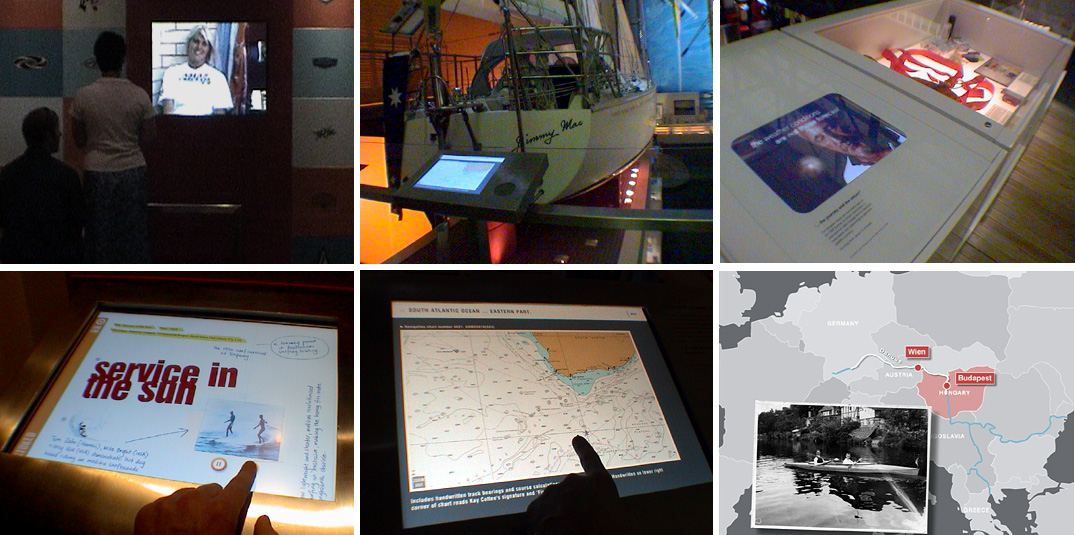
The exhibition spanned two levels – the ground floor, and an L-shaped mezzanine from which visitors could view various watercraft included in the exhibition.
Water / Bodies
Water/Bodies was a compilation of excerpts selected from the archival footage and contemporary media used throughout the exhibition. It served as a visually thematic introduction for visitors and was presented on a video-cube installed flush into a plasterboard wall.
Watermarks Soundscape
I commissioned David Chesworth of Wax Sound Media to create a multi-speaker soundscape for the ground floor gallery, to create an ‘acoustic signature’ adding to the depth, complexity and enjoyment of the visitor experience in the exhibition.
Swimming
‘Watermarks’ Senior Curator Peter Emmett proposed a visual investigation of the history of swimming – the natatorial arts. Jisuk Han, X Squared Design, devised a system of ‘blades’ to support a photo-essay graphic treatment.
Three small LCD video panels were integrated into the blades, for which CDP produced three separate 20 minute video sequences, breaking the 20th century into three timezones.
CDP and ANMM curatorial staff did extensive archival research to identify media elements for the compilations. Amazing footage was unearthed from film newsreels and home movies.
Stoked Surfing Interactive
I worked with ANMM curator Penny Cuthbert, an expert on surf culture, and Adelaide company Clinic to create an interactive surfing clips compendium. Visitors used a touchscreen timeline to select and play movie clips on a separate large plasma panel.
I created the touchscreen design using inspiration from surfers’ scrapbooks in the ANMM collections.
Regattas
This was a compilation of archival clips exploring Australians’ history of official water pageantry contrasted with more disorganised fun on the water.
It included official events such as Sydney and Hobart Regattas, and the 1988 Parade of Tall Ships, interspersed with footage from the Darwin Beer Can Regatta, Dragon Boat Races and model boat racing by Torres Strait Islanders filmed by Frank Hurley.
Sydney – Hobart 1999/2000
This was an 11 minute video telling the story of the disastrous 1998 Sydney-Hobart Yacht race.
CDP used custom animations, weather maps, oral accounts and television and documentary footage to reveal and explore the sometimes treacherous conditions of ocean racing. The program provided insight into the unusual weather that led to the disaster, the experiences of the sailors who survived and the personnel involved in the rescue effort, and how the media represented the events.
Ocean Swell
Kay Cottee’s solo round-the-world journey is legend. On the trip she carried a 16mm camera, and used it to capture a series of magnificent ocean-scapes evoking the senses of loneliness, wonder and awe that the ocean-going yachtie knows well.
CDP used this footage to create an emblematic montage of Kay’s courageous journey. It was displayed on a large rear-projection screen installed adjacent to the actual boat she sailed in, First Lady, that takes pride of place in the gallery. David Chesworth created a subtle soundscape to accompany the mute 16mm film.
Kay Cottee Interactive
This was a touchscreen interactive inviting visitors to explore Kay’s journey through her own words, audio recordings, charts and photographs.
CDP devised a screen design based on the chart of Kay’s journey around the world. Visitors selected a location to view media elements derived from Kay’s recordings. In this way, the visitor was provided direct access to Kay’s thoughts and feelings and the highs and lows she experienced.
Jesse Martin
This was a simple interactive allowing visitors to read Jess Martin’s e-mails to the world, written as he undertook his journey as the youngest-ever solo around-the-world yachtsman.
Speck Trek
Oskar Speck was 25 and unemployed when he left Germany by kayak in 1932. Originally intending to find work in a neighbouring country he ended up travelling, by kayak, across the world to Australia. Arriving in 1939, he was immediately interned for the duration of the Second World War.
During his travels, Oscar Speck took photographs and made detailed diary entries. On arrival in the Indonesian archipelago (then the Dutch East Indies) he obtained a 9mm film camera and filmed many remarkable records of everyday life among the coastal peoples he met and camped with.
CDP designer Aaron Seymour created a 12 minute motion graphics map depicting the path Oscar Speck took across the world. His original photos, passport entries, newspaper clippings and a montage created from his many hours of extraordinary unseen footage were incorporated to illustrate the journey.
The program was displayed on a high-resolution LCD monitor set into a showcase containing various mementos, a model and a contemporary ‘Folbot’, the type of one-man kayak he used for his journey.
gary warner 2012
———
Services
design development
executive production
creative direction
content research and coordination
copyright clearances
multimedia design
Contract Period
Feb 2001 — Dec 2001